Delirious New York By Rem Koolhaas: The Film Version (and Review)
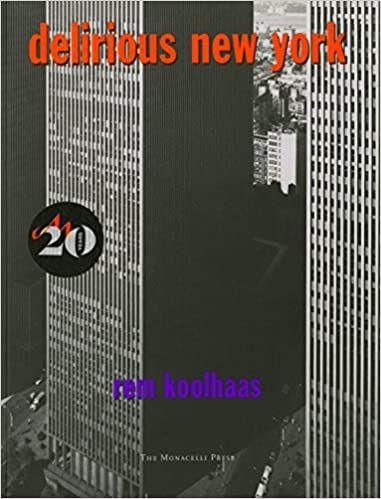
Delirious New York: A Retroactive Manifesto for Manhattan by Rem Koolhaas
Opening shot / A black limousine pulls up in front of a glass skyscraper in Manhattan. The camera is so close to the base of the tower that it appears to go up forever disappearing into the clouds. The light bouncing off the plain glass elevations as though all the glass was reflected back, the only articulation of the building are the reflections of the clouds in the sky. Out gets Edward Norton the famous Hollywood actor, director, writer, polymath he is shown limping into the building.
The book Delirious New York was written in 1978 and pushed OMA and Rem Koolhaas into the spotlight where they have never been out of since. This book helped OMA became the architectural office probably with the most influence in the Architecture scene from the 90’s into the 2000’s.
Delirious New York is a retroactive manifesto of the Skyscraper and for New York City. The birth of which occurred around 1910 and its death some thirty years later. The manifesto is an unconscious programme embarked on in the city during its massive growth which only now Delirious New York properly reveals.
Blocks
The book is arranged in blocks like that of the city. They are Coney Island, The Skyscraper, Rockefeller Center and Europeans showing the progression and decline of Manhattanism. The fifth Block is the Appendix and is Rem and OMA’s own projects, conscious extrapolations of his theory of the unconscious manifesto of Manhattanism.
Preface New York

Castello Map of New Amsterdam as the first settlers hoped it would be.
First we must introduce New York. Once settled as new Amsterdam, the first map of the place is a future projection of an ideal Dutch township onto the bottom tip of Manhattan island that is never quite built.
In 1672 a Frenchman Jollain creates a birds eye view of New Amsterdam which is a work of imagination, of projection only.

Jollains Map of New Amsterdam, completely fabricated.
It is completely false; none of the information it communicates is based on reality. Yet it is a depiction - perhaps accidental - of the project Manhattan: an urban science fiction.
The city portrayed is an ideal city, a prediction of the future in which all the ideal buildings for a European city are transplanted onto Manhattan island.
The 1811 commissioners proposal for Manhattan is a simple grid of 13 x 156 city blocks. This map brings to an end the speculation over the layout of New York. The future of the city has been proscribed and set.

1811 commissioners proposal for Manhattan
The Grid is, above all, a conceptual speculation. In spite of its apparent neutrality, it implies an intellectual program for the island: in its indifference to topography, to what exists, it claims the superiority of mental construction over reality.
Since Manhattan is finite and the number of its blocks forever fixed, the city cannot grow in any conventional manner.
But the third dimension of height is completely free…..
The first ‘maps’ of New York are all fabrications, projections of the future. New Amsterdam, unattainable, New York as a projection of a European perfect city and New York as pure grid , just program, cost, speculation.
Edward Norton sits back in his chair and starts to explain to The Director/ ‘Who else but a Dutchman could recognise the grid for what it was in New York? The natural topography is ignored for the logic of a manmade grid. Other countries were discovered and fought over but The Netherlands was the only one created by their inhabitants from under the Sea.’
Coney Island

Luna Park opens 1903 Take a Day Trip to The Moon.
Coney island is the birthplace of the Manhattan program, if not the skyscaper itself.
There are three key chapters from Coney islands development.
The Steeplechase (1893), Luna Park (opens 1903) and Dreamland (1904). They lay out a path of ever more ecstatic fantasy. Coney island is electrified and lit at night;
Now the city itself is to be lived in shifts; the electric city, phantom offspring of the “real” city, is an even more powerful instrument for the fulfilment of fantasy.
Luna Park takes you to the surface of the Moon, Dreamland amongst other delights has a;
A simulated flight over Manhattan, before the first airplane has ever flown.
‘I don’t understand’ interjects The Director ’how are these entertainment parks relevant to Manhattan? ’Edward Norten Frowns/ ’Well Coney Island is the birthplace of the model. It is the first part of the city to be electrified open and visible during the night. It is the first part of the city to develop a with a lack of constraint of the normal, where the relationship between spaces, floors, and inside and outside is systematically destroyed. All this plays out in the Manhattan skyscraper.’
The Skyscraper
There is no easy way from the earth to the stars….’
- text on Medalists’ Society Medal, 1933
High buildings, steel frame construction, lifts, all these are the technologies that make high buildings. This is what first developed in New York, Chicago and other cities, but the Skyscraper was born in Manhattan.

Published in Life Magazine in 1909 this project sets out an ideal skyscraper.
The 1909 theorem shows the skyscraper as a utopian device. Every floor is a Virgin piece of land with no relation to what is above or below.
The skeleton of the 1909 theorem postulates the Manhattan Skyscraper as a utopian formula for the unlimited creation of virgin sites on a single urban location.
Electricity, air-conditioning, tubes, telegraphs, tracks and elevators - reappear in Manhattan as paraphernalia of efficiency to convert raw space into office suites.
The Skyscraper then is a tall building in which each floor is not constrained by the floors above or below, it has it’s own built potential. It has on some level independence from the floors around it in a way that is new in buildings.
1902 the Flatiron building repeats its site 22 times but every new Skyscaper adds more floors. Soon things in Manhattan get out of hand. The 1916 zoning law tries to bring the chaos under some sort of control.
The 1916 Zoning Law describes on each plot or block of Manhattan’s surface an imaginary envelope that defines the outlines of the maximum allowable construction.
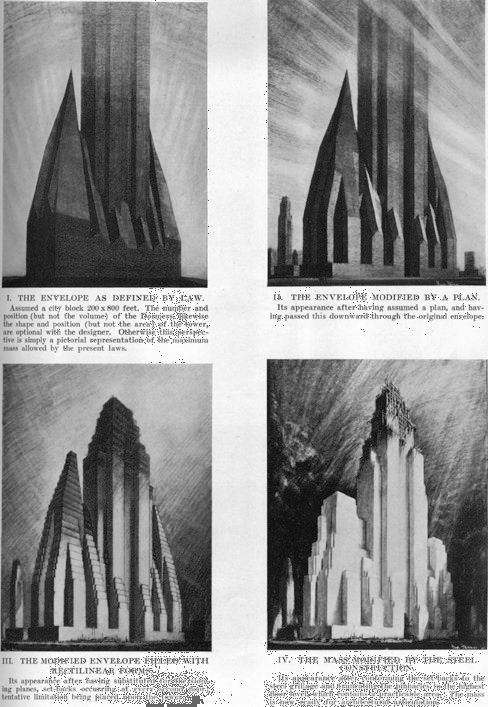
Hugh Ferriss illustrates the zoning Law in 1922
Hugh Ferriss is the artist of the skyscraper he works in Charcoal. In a long and fabulous career he becomes the artist of choice for every major skyscraper project. He visualises the Manhattan Skyscaper in black on white and white on black. His imagery so powerful it illustrates the night time Gotham to the daytimes Metropolis.
Waldorf-Astoria Hotel / Empire State Building
The site on which the Waldorf Astoria first appear changes from grassland to supporting the highest and most valuable building known to man in the space of 150 years.
The Waldorf Astoria becomes the hotel which breaks down the difference between hotel and home. The ballroom, restaurants and bars for public entertaining. Room service is created here so the play of home living can be seamless. The modern metropolitan elite no longer have to run their own town houses just take some rooms at the Waldorf-Astoria.
Barely 20 years after the Waldorf-Astoria opens its doors as one of the most luxurious hotels in the world it is rebuilding itself. To preserve its tradition it is growing, modernising continuously.
The model of the hotel undergoes a conceptual overhaul and is invested with a new experimental ambition that creates Manhattan’s definitive unit of habitation, the Residential Hotel—place where the inhabitant is his own houseguest, instrument that liberates its occupants for total involvement in the rituals of metropolitan life.
Again the Waldorf Astoria must grow it moves to a new site and the original will be taken up by the greatest skyscraper of all The Empire State Building.
‘So’ says The Director/ ’the skyscraper has a kind of crazy logic in which the program becomes irrelevant to the Architectural form, which rises upwards according to a logic which is predetermined while the internal program itself which becomes independent of the building and from the surrounding floors.’/ Edward Norton smiles and nods.
The Downtown Athletic club
The Apotheosis of the idea of the skyscraper is the Downtown Athletic club. Women are not allowed in the lower twelve floors. Each level describes a different ‘performance’ of the rich bachelor life the Athletic club is selling. The seventh floor a golf course, the ninth floor devoted to boxing with an oyster bar with views out to the city, the tenth is a Turkish bath and massage parlour, the twelfth floor a swimming pool.
On the outside the building is merely a grouping of articulated brick boxes. A strict play within the limits of the 1916 Zoning Law.
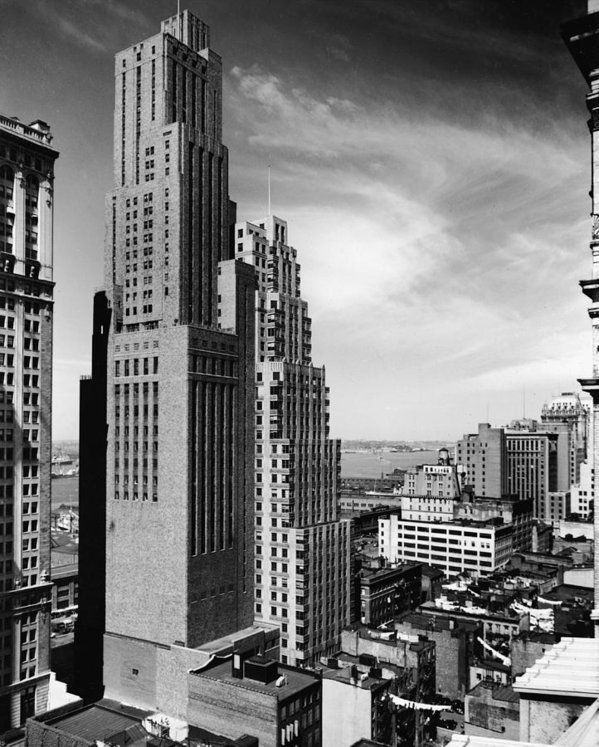
Downtown Athletic Club 1931
Rockefeller Center
At the heart of Rockefeller Center—the first installment of that final, definitive Manhattan—is a double paradox that only Manhattanism could transcend: The Center must combine the maximum of congestion with the maximum of light and space
The project starts as a search for a new building for the Metropolitan Opera in 1926. But in the Manhattan of the 20’s the Opera can only exist by itself as a discreet building in the worst of locations, the better the location the more the land price means that the opera must add commercial functions to make the building commercially feasible.
The Rockefeller Center is designed by Associated Architects a group of otherwise separate Architects and their firms brought together to design the center. Traditionally seen as a kind of compromise design, rather it is the final example of what all New York Skyscrapers are, designs by committee.
There is no ‘design’ rather a process of extracting the most program from within the constraints of the 1916 zoning law.
Something else happens during the planning of The Center. The 1929 crash which removes any commercial demand from The Center no one needs it. But Rockefeller must go on, he has signed a lease for the site and must pay so he must keep developing. However with all the commercial pressure gone there are no commercial requirements, they must all be planned in a vacuum so there can only be an ideal development.
Associated Architects are organised on two floors. On the top floor all the Architects meet so that their ideas can be added to the current ones. The lower floor contains sculptors, drafters, technicians to work up and revise multiple different schemes all at once. There are phone lines to all the other parts of the office as well as the engineers, blueprinting companies etc.
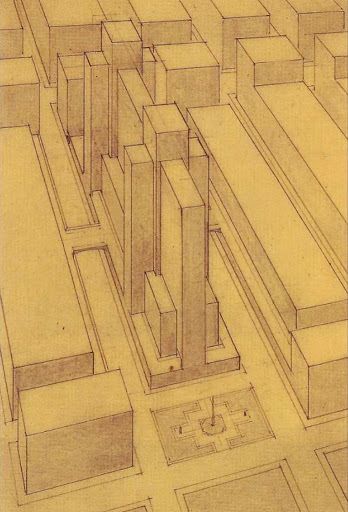
December 19 -23 1929 A proposal by Walter Kilham Jr working for Hood for Rockefeller Center.
The Rockefeller Center emerges from tens of thousands of designs with hundreds of contributors there is no author, it emerges with hundreds of thousands of square foot of space for which there is no demand, it is the apotheosis of Manhattanism.
The Rockeller Center is a masterpiece without a Genius
Edward Norten jumps out of his chair./ ‘The perfect Architects office, fully integrated anonymous designers to find the best possible design out of all the given specifics of the building brief. This is the prototype Architects studio of the future. Think what you could design with this!’/The Director looks suspicious.
Congestion
It is the extreme growth of Manhattan that has caused this From 1890 to 1940 the population of New York grows from approx 1.5 to 7.5 million. In 1925 it becomes the largest city in the world overtaking London and won’t loose the title until the mid sixties (to Tokyo).
Congestion itself is the essential condition for realizing each of these metaphors in the reality of the Grid. Only congestion can generate the super-house, the Mega-Village, the Mountain and finally the modernized automotive Venice. Together, these metaphors are the foundation of a Culture of Congestion, which is the real enterprise of Manhattan’s architects.
This is the Doctrine of Congestion, that Manhattanism is not just the result of congestion or that the buildings would try to alleviate any of it’s symptoms, it is that they actively create congestion.
The Europeans Dali and Le Corbusier Invasion Repelled
Dali
Dali arrived to Conquer Manhattan in 1935. He arrives with the longest baguette he can contrive to bake and the New Yorkers barely bat an eyelid. He finds a city that is already delirious, what is shocking for Europe is normal here.
He draws the city skyscrapers as people.
Dali has developed a Paranoid Critical Method to subvert the normal.
PCM is best described by it’s opposite. The opposite would be something like Reinforcement Theory. You can apply this theory to patients who exhibit antisocial behaviour. If they are rewarded when they behave in a socially acceptable manner then the theory holds that through this reinforcement of normal behaviour eventually the desired behaviour is produced by itself instead.
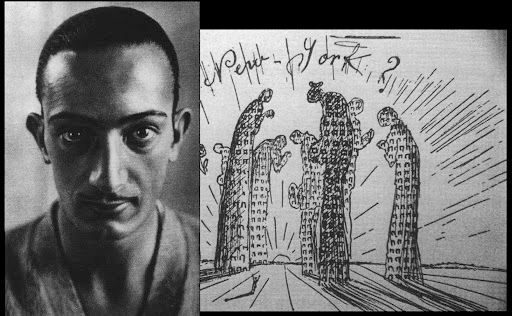
Dali and his drawings of the buildings as people.
PCM is the same but opposite;
instead of the diseased performing the rituals of health, Dali proposes a tourism of sanity into the realm of paranoia
Dali the artist who plays with perception above all else arrives in New York hopeful to shock America with his PCM but he realises it’s already alive in Manhattan, he falls in love with the city and comes back every winter for forty years.
Le Corbusier
Corbusier expects a noisy reception to Manhattan, but no one turns up to greet him.
He has spent the last few years peddling his Radiant City idea. A city of super high towers separated independently from the ground below a park. Corbusier has built some localised buildings according to this model the Unité d’habitations, but has bigger ambitions.
He has been denigrating the New York Skyscraper trying to show New York is not yet modern.

Radiant City plan for Paris
By trying to fix the skyscraper to reimagine it Corbusier is trying to retroactively become the creator of the skyscraper. It’s a neurosis that seems easy to associate to Corbusier if you are familiar with hm. His metaphorical stalking and takeover of E1027 smacks of the same Psyhchosis.
Le Corbusier greedily tries to take the UN building Commission. The UN is the project with which Corbusier hopes that he can reform New York, prise it open and finally build his vision, but he overreaches himself. His proposal is the one taken forward but he is not allowed to lead the project. The building is absorbed by the city.
Le Corbusier has after all not swallowed Manhattan. Manhattanism has choked on, but finally digested, Le Corbusier.
Appendix
The original project was a subconscious doctrine, how might a self-conscious Manhattan develop? The projects here all seem like fantasy projects but look a little closer and themes from the Future OMA come into view. The Anonymous Office, the logic of the program and the interplay of otherwise unrelated activities next to each other. Perhaps even the use of the Paranoid Critical Method (PCM) as a design tool?
The Director looks back at Edward Norton./ ‘I am afraid we can’t give you funding for this script, it just wouldn’t work on the screen’ sighs the Director. Edward Norton springs up. ‘This isn’t a film this is an Architectural project I will build a studio in which the PCM will thrive and use it to become the worlds most influential Architect!’ / Edward Norton Storms out
Conclusion
You could read Delirious Manhattan as an OMA manifesto as these themes cascade through the work of OMA here and are themes in their work even now. It is a little simplistic and unfair as through the years of practice, of adjustment and of living some of these themes have probably been dropped or altered and many other ideas have come and gone. But often OMA and Rem Koolhaas are talked about as the kind of office where the ‘house style’ is hard to identify or fathom. I don’t believe this is true, people just look in the wrong places.
Delirious New York was a Retrospective Manifesto for New York but unbeknownst to Rem Koolhaas the Author it became a future prediction of the path of the most influential architects office OMA at the turn of the Millenium.
Outside on the street the hobbling Edward Norton starts walking faster and faster, he throws away his walking sticks and appears to grow taller and go bald. A man who looks a lot like Rem Koolhaas starts laughing as he walks down the New York sidewalk.
Architecture is inevitably a form of PC (Paranoid Critical) activity
-Rem Koolhaas